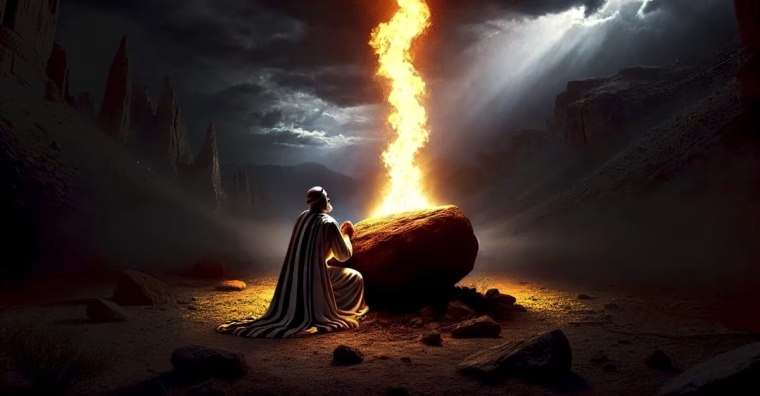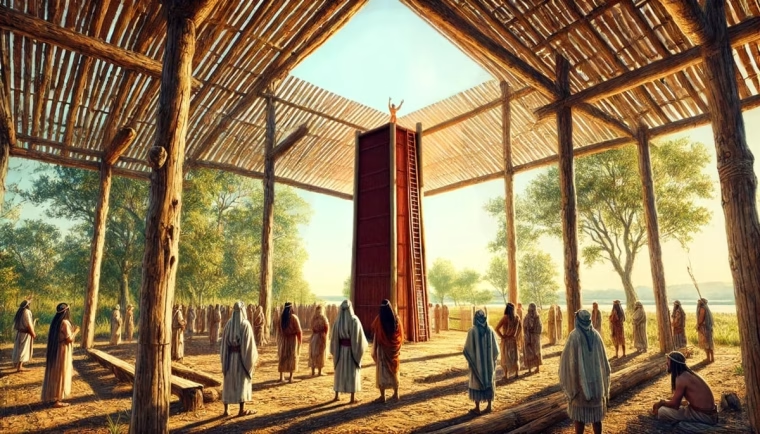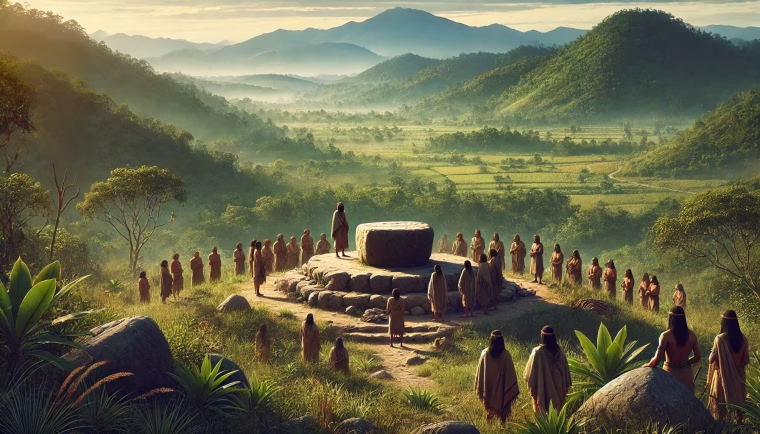I was reading Alma 15 and came across this verse:
…the people were checked as to the pride of their hearts, and began to humble themselves before God, and began to assemble themselves together at their sanctuaries to worship God before the altar, watching and praying continually…
Alma 15:17
At first I thought that this must have meant that they were gathering at their temples, but then, a few days later, I was reading in the next chapter and came across this verse:
And Alma and Amulek went forth preaching repentance to the people in their temples, and in their sanctuaries, and also in their synagogues, which were built after the manner of the Jews.
Alma 16:13
It appeared to me that temples, synagogues, and sanctuaries were three different things. I knew what temples and synagogues were, but what were sanctuaries?
I can’t believe that I never noticed that before, but sanctuaries/sanctuary are mentioned about 10 times in the Book of Mormon.
- And he shall be for a sanctuary; but for a stone of stumbling, and for a rock of offense to both the houses of Israel, for a gin and a snare to the inhabitants of Jerusalem. (2 Nephi 8:14)
- They rob the poor because of their fine sanctuaries… (2 Nephi 28:13)
- Behold, we have built sanctuaries, and we do assemble ourselves together to worship God (Alma 21:6)
- …and I have granted unto them that they should build sanctuaries… (Alma 22:7)
- …but that they should have free access to their houses, and also their temples, and their sanctuaries. (Alma 23:2)
- …that in time they might have timber to build their houses, yea, their cities, and their temples, and their synagogues, and their sanctuaries, and all manner of their buildings. (Helaman 3:9)
- …and their wars, and contentions, and dissensions, and their preaching, and their prophecies, and their shipping and their building of ships, and their building of temples, and of synagogues and their sanctuaries… (Helaman 3:14)
- And that it was the place of the New Jerusalem, which should come down out of heaven, and the holy sanctuary of the Lord. (Ether 13:3)
There are five mentions of “sanctuaries” (plural) in the Old Testament and 128 mentions of the singular “sanctuary,” four of which appear in the New Testament.
- Only he shall not go in unto the veil, nor come nigh unto the altar, because he hath a blemish; that he profane not my sanctuaries: for I the Lord do sanctify them. (Lev. 21:3)
- And I will make your cities waste, and bring your sanctuaries unto desolation, and I will not smell the savour of your sweet odours. (Lev. 26:31)
- …for strangers are come into the sanctuaries of the Lord’s house. (Jer. 51:51)
- Thou hast defiled thy sanctuaries by the multitude of thine iniquities… (Eze. 28:18)
- And the high places of Isaac shall be desolate, and the sanctuaries of Israel shall be laid waste… (Amos 7:9)
The term sanctuary (Hebrew: מִקְדָּשׁ, miqdash) means “a holy place” or “a place set apart.” It originally referred to the Tabernacle during the wilderness period, which was the portable dwelling where God’s presence was manifest among the Israelites (Exodus 25:8-9). Later, it referred to the Temple in Jerusalem, which was the permanent structure that replaced the Tabernacle.
In the history of Israel, various high places and sanctuaries outside Jerusalem were used for worship.
Some were established by kings, such as Jeroboam’s sanctuaries in Bethel and Dan, which included unauthorized altars and idols (1 Kings 12:28-30). These were often condemned by the prophets as idolatrous (e.g., Amos 7:9).
It seems that while all temples were sanctuaries, not all sanctuaries were temples; especially in the Book of Mormon.
This is significant because the Book of Mormon people preserved forms of worship that were restricted under the reign of Josiah who had done numerous things to alter the Israelite religion.
Worship was centralized around the temple in Jerusalem and any altars, sanctuaries, or high places, were banned. The menorah of the temple was desecrated and destroyed, and teachings about angels and revelations where no longer allowed.
The Book of Mormon begins by subverting these teachings with Lehi offering sacrifices in the desert outside of Jerusalem (1 Nephi 2:7), having visions (1 Nephi 1,8), and visitations of angels to his sons. (1 Nephi 3:29)

I think that it is also possible that the practice of having these sanctuaries parallel to temples and synagogues is also a practice they carried over from a more ancient time that was subsequently lost after Josiah’s reforms and throughout post-exilic Israel.
In doing a deeper dive into this, I found A. Keith Thompson’s paper Nephite insights into Israelite Worship Practices before the Babylonian Captivity where these Nephite sanctuaries are discussed.
Thompson notes that the worship sanctuaries were likely a pre-exilic relic.
…the existence of synagogues and worship sanctuaries in the Book of Mormon, which must date back to pre-exilic times, means that there must have been synagogues and sanctuaries in Israel much earlier than most synagogue origins scholars have considered.
I was pleased to find that Thompson was thinking along the same lines as I was and I realized what a profound idea that the existence of these kinds of places of worship existed.
Since the Book of Mormon account makes a distinction between Temples, Synagogues, and Sanctuaries which must have originated in pre-exilic times, a review of the existing scholarship on pre-exilic worship practices is additionally useful since it may yield reciprocal understanding of the differences between these three different types of religious buildings—both among the descendants of Lehi and Mulek on the American continent, and in ancient Israel before both Lehi and Mulek departed Jerusalem.
Thompson references Roland de Vaux, who proposed that these sanctuaries were ultimately condemned because they became corrupted by syncretism—the blending of authentic worship practices with local pagan traditions, leading to a distortion of true worship.
I find it interesting that we have an account of this very thing happening in the the Book of Mormon where a synagogue among the Zoramites becomes corrupted by the addition of a “holy stand” they called Rameumptom and the apostate practices they associated with it.

Thompson continues with de Vaux’s description of how worship became more centralized under David.
Shiloh and Bethel have already been mentioned, but de Vaux says there were also sanctuaries at Mizpeh, Gibeon, Ophra, and Dan. However, de Vaux says that it is David’s installation of the Ark at Jerusalem which changed the focus of common worship forever. Jerusalem was David’s “own personal conquest, and did not belong to the territory of any of the Twelve Tribes.” Not only was this place sacred from Abrahamic times, but David there restored the Ark, set up an altar, and thus made Jerusalem “heir to the sanctuary of Shiloh and to the Tent in the desert.”
Josiah and Hezekiah’s efforts to centralize worship at the temple in Jerusalem didn’t last beyond their lifetimes. Thompson explains that Anders Runesson argues that high places were still in use when the exiles returned, suggesting that centralization was a temporary phenomenon.
De Vaux disagrees, seeing Josiah’s reforms as planting a seed that eventually triumphed, shaping the future of Israelite worship; seems there is still a lot of conflict between scholars on this.
Both de Vaux and Runesson agree that there was local worship in sanctuaries before the centralization efforts of both Hezekiah and Josiah. Josiah’s redaction of the law in the book of Deuteronomy changed the practice in the future, but worship in Israel before the exile was local in character. The Deuteronomic redaction may well be responsible for the impression which the Pentateuch leaves that there was no local worship in Israel before or after the exile. But it is still possible to glean some evidence of local worship in what remains of those first five books of scripture which have come down to us in the Judeo-Christian Bible.
There’s a lot to this and I highly recommend reading the whole article because it’s worth reading everything and not simply relying on my summary alone.
I did find this part interesting especially since I’ve just come out of a deep dive on Alma and Amulek’s sermons to the Zoramite poor.
The retreat of the poor among the Zoramites to the hill Onidah to hear Alma and Amulek preach since they had all been excluded from the synagogue, reminds us that the Israelites from time immemorial had built altars and worshipped in high places before they built Temples and presumably synagogues and other sanctuaries. It is further noteworthy that Onidah is used in respect of two different places in the Book of Mormon, both of them raised places of gathering, retreat and perhaps even sanctuary (Alma 32:4; 47:5). While it is possible they were the same place, we cannot be sure from the limited text provided by Alma and Mormon. If they are not, Onidah may have some generic sacred significance in denoting a hill, mountain, or other traditional high place but without any formal religious structure yet erected upon it.
Hills or high places may have been used when there were no other buildings or structures present where the Nephites and perhaps Israelites would have worshipped until they built temples and synagogues. But perhaps those high places remained and were still used thereafter.

It’s possible that altars may have been present in the beginning at a sanctuary and maybe they were converted to synagogues or temples at some point as well.
I think it’s significant that Thompson observes Alma the high priest taking the poor to a high place, and perhaps a sanctuary, when they are cast out to remind them that their relationship with God is not entirely dependent on a building or structure.
Here are Thompson’s final words from his article:
Traditional Jewish scholarship holds that synagogues did not exist before the exile, that synagogal worship evolved in Babylon as a response to separation from the Temple in Jerusalem. But a more holistic view of Israelite religious practice after the exodus from Egypt suggests that Moses and Joshua must have made provision for local worship where the tribes which were to settle in Palestine were necessarily separate from, first, the portable tabernacle at Shiloh and, later, Solomon’s Temple at Jerusalem. That the Nephites built not only a temple, but also synagogues, sanctuaries, and other places of worship after their exodus from Jerusalem suggests that the practice of local worship in synagogues or like places of worship was much older than the Jewish exile in Babylon.
Sanctuaries in the Book of Mormon provide a unique window into Nephite worship and their connection to ancient Israelite traditions. Unlike the centralized worship mandated by Josiah’s reforms, these sanctuaries suggest a localized, more accessible form of worship that the Nephites preserved from pre-exilic times.
As populations grew and spread across the land, having local places of worship made practical sense. Traveling from city to city could take days and often posed dangers, making a single central sacred space less feasible.
However, this convenience came at a cost. A dispersed people, with less frequent contact, were more vulnerable to the introduction and spread of corrupt practices. Sanctuaries, while not inherently corrupt, appear to have been particular targets for distortion both among the Nephites and in ancient Israel.
Despite these risks, the Nephites continued to use sanctuaries alongside temples and synagogues at least up until the time of Christ. I couldn’t find any mention of sanctuaries after His visit, which may indicate a significant shift in worship practices with the establishment of His church.
These sanctuaries appear to bridge the gap between the high places of ancient Israel and the more formalized worship structures of temples and synagogues.
Their presence in the Nephite record reflects the continuation of pre-exilic traditions that were lost or transformed in post-exilic Judaism. Their role invites further exploration into the evolution of Israelite worship, illuminating how practices adapted to local needs while striving to maintain sacred connection.
Other thoughts
How do we prevent the corruption of doctrine and practices? Today the modern LDS church has correlated much of its doctrine and teachings to prevent any individual congregation from going off into the weeds.
I think that can be one of the pros, but I wonder if one of the cons is that many might be afraid to pursue the mysteries of God and have the type of encounters that Lehi had for fear of operating outside of correlated teachings.
What’s the balance between avoiding mass apostasy on the one hand and avoiding mass complacency on the other?


2 Comments
Each of us has the potential to receive the revelations of the prophets. The scriptures contain powerful examples of what’s possible.
Avoiding apostasy and complacency comprises several principles. Hugh Nibley exemplified balance in publicly teaching official doctrine while privately seeking further light. In one subject, he went so far as to covenant not to discuss what he knew (which knowledge might have been informed, at least in part, by his NDE). He also lived some principles in uncommon ways, such as in consecrating his earnings and avoiding the potential pride of costly apparel.
Yeah, I think that there is a public version of the religious practice that can be a framework on which we can connect with one another and have some bearings as a people but individually, we are all on separate journeys and shouldn’t forever linger on the framework and feel “safe” there, we have to venture out to experience our own encounters with God. Often, that can require interactions with others in ways that they may be oblivious to such as forgiveness, or going to serve someone only for them to say something that is a clue to you on your journey.